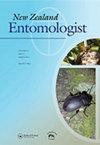The effects of squid-baiting pitfall traps for sampling wētā (Orthoptera) and other ground-dwelling forest invertebrates
IF 0.4
4区 农林科学
Q4 ENTOMOLOGY
引用次数: 0
Abstract
ABSTRACT Pitfall traps are commonly used to sample surface-active invertebrates, although the efficiency of the technique varies among taxa. We investigated how baiting pitfall traps with squid influenced sampling of some ground-dwelling invertebrates in New Zealand forests. The study was conducted across a total of 21 sets of seven lethal pitfall traps established between November 2012 and November 2015 in Aorangi and Remutaka forests. Four non-baited and three squid-baited lethal pitfall traps were established per set and remained active for one night during November/December and three nights during February. Squid-baited pitfall traps caught four times as many ground wētā and three times more cave wētā per unit effort than unbaited traps. Most of the ground wētā were identified as Hemiandrus pallitarsis (Walker, 1869). Carabidae, Scarabaeidae, Staphylinidae, Opiliones, Hymenoptera and Araneae were also more abundant in squid-baited than in unbaited traps. There was little difference in the catches of peripheral pitfall traps versus central pitfall traps, suggesting that 5 m spacing is sufficient to generate independent samples. Exceptions were Araneae and Amphipoda which were both approximately 1.5 times more abundant in central compared to peripheral unbaited traps. The attraction of ground and cave wētā to squid provides some insight into their dietary range. The higher catches obtained with squid-baiting, suggests this may be a useful modification to increase sampling rates, which is valuable where sampling effort is logistically constrained such as on islands or other remote study sites.鱿鱼饵陷阱对wētā(直翅目)和其他地栖森林无脊椎动物取样的影响
陷阱陷阱通常用于对表面活性无脊椎动物进行采样,尽管该技术的效率因分类群而异。我们研究了用乌贼诱捕诱饵如何影响新西兰森林中一些陆生无脊椎动物的采样。这项研究是在2012年11月至2015年11月期间在Aorangi和Remutaka森林建立的共21套7个致命陷阱中进行的。每套设有4个无饵陷阱和3个以鱿鱼为饵的致命陷阱,在11月/ 12月和2月分别有1晚和3晚有效。以鱿鱼为诱饵的陷阱每单位捕获的地面wētā和洞穴wētā的数量是无诱饵陷阱的四倍。大部分地面wētā被鉴定为半雄鸟(半雄鸟,1869)。鱿鱼饵饵中甲虫科、金甲科、刺甲科、拟姬科、膜翅目和蜘蛛科的数量也高于无饵饵饵饵。外围陷阱和中心陷阱的捕获量差异不大,表明5 m的间距足以产生独立的样本。例外的是蜘蛛目和片足目,它们在中心的数量都是外围无饵陷阱的1.5倍。地面和洞穴wētā对鱿鱼的吸引力让我们对它们的饮食范围有了一些了解。用鱿鱼诱饵获得的更高渔获量表明,这可能是一种有用的改进,以提高抽样率,这在抽样工作受到后勤限制的地方是有价值的,例如在岛屿或其他偏远的研究地点。
本文章由计算机程序翻译,如有差异,请以英文原文为准。
求助全文
约1分钟内获得全文
求助全文
来源期刊

New Zealand Entomologist
ENTOMOLOGY-
CiteScore
0.70
自引率
33.30%
发文量
3
审稿时长
>12 weeks
期刊介绍:
The invertebrate diversity of New Zealand is of great interest worldwide because of its geographic isolation and geological history. The New Zealand Entomologist plays an important role in disseminating information on field-based, experimental, and theoretical research.
The New Zealand Entomologist publishes original research papers, review papers and short communications. We welcome submissions in all aspects of science regarding insects and arthropods in a New Zealand or Australasian setting. The journal’s subject matter encompasses taxonomy, phylogenetics, biogeography, biological control and pest management, conservation, ecology and natural history.
The journal is the official publication of the Entomological Society of New Zealand. Papers published or submitted elsewhere for publication will not be considered, but publication of an abstract or summary elsewhere (e.g. conference proceedings) does not preclude full publication in the New Zealand Entomologist. Accepted papers become copyright of the Entomological Society of New Zealand. The journal is published in English, but we also welcome publication of abstracts in Maori.
 求助内容:
求助内容: 应助结果提醒方式:
应助结果提醒方式:


